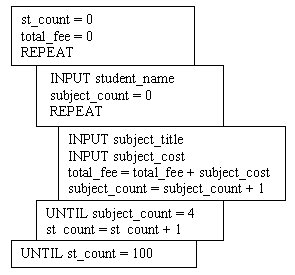More work with loops and sequence
After completing this lesson you should be able to:
- describe and use nested loops
- describe and use compound statements
- use indentation to show program structure
Return to the index
Go to the next lesson
Return to the previous lesson
Nesting loops - loops within loops
The situations where nested loops might be used are quite common, they
are the kind of situation where we need to get a piece of data from a number
of pieces and carry out some processing on each piece. For example we might
be reading student records from a disk drive and for each student record
we might count the number of subjects that the student is enrolled in and
calculate what fees the student should pay.
Here are some examples of the structure of nested loops:
REPEAT
REPEAT
...
UNTIL Inside_Loop_Done
UNTIL Outside_Loop_Done
REPEAT
REPEAT
REPEAT
...
UNTIL End_1
UNTIL End_2
UNTIL End_3 |
DOWHILE In_Loop_1
DOWHILE In_Loop_2
...
END DOWHILE
END DOWHILE
DOWHILE In_Loop_1
DOWHILE In_Loop_2
DOWHILE In_Loop_3
...
END DOWHILE
END DOWHILE
END DOWHILE |
To demonstrate the use of nested loops I'll borrow the student records
example from above. Assume that we have a database of student records and
each student record is something like:
- Student name
- Subject title, subject cost
- Subject title, subject cost
- Subject title, subject cost
- Subject title, subject cost
There are one hundred students and each student is enrolled in four subjects.
I need to know the total fees that will be collected.
Repeat and While nested loops
st_count = 0
total_fee = 0
REPEAT
INPUT student_name
subject_count = 0
REPEAT
INPUT subject_title
INPUT subject_cost
total_fee = total_fee + subject_cost
subject_count = subject_count + 1
UNTIL subject_count = 4
st_count = st_count + 1
UNTIL st_count = 100 |
st_count = 0
total_fee = 0
DOWHILE st_count < 100
INPUT student_name
subject_count = 0
DOWHILE subject_count < 4
INPUT subject_title
INPUT subject_cost
total_fee = total_fee + subject_cost
subject_count = subject_count + 1
END DOWHILE
st_count = st_count + 1
END DOWHILE |
There is no real limit to how deeply loops can be nested but it is not
common to find loops nested more than three deep.
The compound statement and indentation

You have probably noticed that I have tended to use indentation within loops.
There is a method to my madness. One aim is to make the algorithms easier
to read; the other is to stress that processes that are indented to the
same level belong together. In the diagram here I have exaggerated and
outlined the indentation so that you can see how the statements in the
algorithm belong together. In some cosmetic respects it isn't necessary
to use indentation but there is a situation where the use of indentation
is mandatory, otherwise your program designs are going to be misleading
or, worse, wrong.
|
For instance: Is the piece of pseudocode on the left different from the piece on the right?
x = 22
y = 1
IF x = = 22
THEN y = x + 7
z = y + 2
j = z + 9
DISPLAY y, z, j |
x = 21
y = 1
IF x = = 22
THEN y = x + 7
z = y + 2
j = z + 9
DISPLAY y,z,j |
There is no obvious difference except that the code on the right uses
indentation and the indentation is meant to show that the statements y
= x + 7, z = y + 2 and j = z + 9 will only execute if x =
= 22 is true. This kind of arrangement of statements is called
a compound statement.
Often when using the IF statement it isn't necessary to use ENDIF but
in cases where compound statements are used it is better to make use of
ENDIF to avoid any confusion:
x = 22
y = 1
IF x = = 22
THEN y = x + 7
ENDIF
z = y + 2
j = z + 9
DISPLAY y, z, j |
x = 21
y = 1
IF x = = 22
THEN y = x + 7
z = y + 2
j = z + 9
ENDIF
DISPLAY y,z,j |
Summary
In this lesson you studied the nesting of loops and the use of indentation
and compound statements. This was quite a short lesson which built on the
material learned in the previous lesson on pseudocode. The next lesson
introduces some new topics which basically represent the end of the
material which is relevant to all the methods of designing programs introduced
in this course.
Return to the index
Go to the next lesson
Return to the previous lesson
This publication is copyright David Beech and Learning Systems 1997-2002
and may not be reproduced by any means without the written permission of
David Beech.
9 Wyndella Street, Tasmania, Australia
db@codelearn.com
